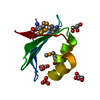[English] 日本語
 Yorodumi
Yorodumi- PDB-7x8c: Crystal structure of a KTSC family protein from Euryarchaeon Meth... -
+ Open data
Open data
- Basic information
Basic information
| Entry | Database: PDB / ID: 7x8c | |||||||||
|---|---|---|---|---|---|---|---|---|---|---|
| Title | Crystal structure of a KTSC family protein from Euryarchaeon Methanolobus vulcani | |||||||||
 Components Components | KTSC domain-containing protein | |||||||||
 Keywords Keywords | DNA BINDING PROTEIN / ARCHAEA / KTSC DOMAIN-CONTAINING PROTEIN / SINGLE-STRANDED | |||||||||
| Function / homology | KTSC domain / KTSC domain / KTSC domain-containing protein Function and homology information Function and homology information | |||||||||
| Biological species |  Methanolobus vulcani (archaea) Methanolobus vulcani (archaea) | |||||||||
| Method |  X-RAY DIFFRACTION / X-RAY DIFFRACTION /  SYNCHROTRON / SYNCHROTRON /  MOLECULAR REPLACEMENT / Resolution: 2.73 Å MOLECULAR REPLACEMENT / Resolution: 2.73 Å | |||||||||
 Authors Authors | Zhang, Z.F. / Zhu, K.L. / Chen, Y.Y. / Cao, P. / Gong, Y. | |||||||||
| Funding support |  China, 2items China, 2items
| |||||||||
 Citation Citation |  Journal: Int.J.Biol.Macromol. / Year: 2022 Journal: Int.J.Biol.Macromol. / Year: 2022Title: Biochemical and structural characterization of a KTSC family single-stranded DNA-binding protein from Euryarchaea. Authors: Tian, L. / Zhu, K. / Chen, Y. / Zheng, X. / Zhang, H. / Geng, Z. / Li, W. / Ding, N. / Chen, J. / Dong, Y. / Cao, P. / Gong, Y. / Zhang, Z. | |||||||||
| History |
|
- Structure visualization
Structure visualization
| Structure viewer | Molecule:  Molmil Molmil Jmol/JSmol Jmol/JSmol |
|---|
- Downloads & links
Downloads & links
- Download
Download
| PDBx/mmCIF format |  7x8c.cif.gz 7x8c.cif.gz | 72 KB | Display |  PDBx/mmCIF format PDBx/mmCIF format |
|---|---|---|---|---|
| PDB format |  pdb7x8c.ent.gz pdb7x8c.ent.gz | 52.3 KB | Display |  PDB format PDB format |
| PDBx/mmJSON format |  7x8c.json.gz 7x8c.json.gz | Tree view |  PDBx/mmJSON format PDBx/mmJSON format | |
| Others |  Other downloads Other downloads |
-Validation report
| Summary document |  7x8c_validation.pdf.gz 7x8c_validation.pdf.gz | 456.9 KB | Display |  wwPDB validaton report wwPDB validaton report |
|---|---|---|---|---|
| Full document |  7x8c_full_validation.pdf.gz 7x8c_full_validation.pdf.gz | 462.2 KB | Display | |
| Data in XML |  7x8c_validation.xml.gz 7x8c_validation.xml.gz | 13.2 KB | Display | |
| Data in CIF |  7x8c_validation.cif.gz 7x8c_validation.cif.gz | 17.7 KB | Display | |
| Arichive directory |  https://data.pdbj.org/pub/pdb/validation_reports/x8/7x8c https://data.pdbj.org/pub/pdb/validation_reports/x8/7x8c ftp://data.pdbj.org/pub/pdb/validation_reports/x8/7x8c ftp://data.pdbj.org/pub/pdb/validation_reports/x8/7x8c | HTTPS FTP |
-Related structure data
| Related structure data |  4rgiS S: Starting model for refinement |
|---|---|
| Similar structure data | Similarity search - Function & homology  F&H Search F&H Search |
- Links
Links
- Assembly
Assembly
| Deposited unit | 
| ||||||||||||
|---|---|---|---|---|---|---|---|---|---|---|---|---|---|
| 1 |
| ||||||||||||
| Unit cell |
|
- Components
Components
| #1: Protein | Mass: 8170.230 Da / Num. of mol.: 4 Source method: isolated from a genetically manipulated source Source: (gene. exp.)  Methanolobus vulcani (archaea) / Gene: SAMN04488589_2454 / Production host: Methanolobus vulcani (archaea) / Gene: SAMN04488589_2454 / Production host:  #2: Chemical | #3: Water | ChemComp-HOH / | Has ligand of interest | N | |
|---|
-Experimental details
-Experiment
| Experiment | Method:  X-RAY DIFFRACTION / Number of used crystals: 1 X-RAY DIFFRACTION / Number of used crystals: 1 |
|---|
- Sample preparation
Sample preparation
| Crystal | Density Matthews: 1.94 Å3/Da / Density % sol: 36.59 % |
|---|---|
| Crystal grow | Temperature: 289 K / Method: vapor diffusion, sitting drop / pH: 8.5 Details: 0.1 M SUCCINATE-PHOSPHATE-GLYCINE BUFFER (PH8.5) AND 25% PEG 1500 |
-Data collection
| Diffraction | Mean temperature: 100 K / Serial crystal experiment: N |
|---|---|
| Diffraction source | Source:  SYNCHROTRON / Site: SYNCHROTRON / Site:  SSRF SSRF  / Beamline: BL17U1 / Wavelength: 0.98 Å / Beamline: BL17U1 / Wavelength: 0.98 Å |
| Detector | Type: ADSC QUANTUM 315r / Detector: CCD / Date: Dec 28, 2020 |
| Radiation | Protocol: SINGLE WAVELENGTH / Monochromatic (M) / Laue (L): M / Scattering type: x-ray |
| Radiation wavelength | Wavelength: 0.98 Å / Relative weight: 1 |
| Reflection | Resolution: 2.73→50 Å / Num. obs: 7166 / % possible obs: 99.8 % / Redundancy: 11.7 % / Biso Wilson estimate: 38.19 Å2 / Rmerge(I) obs: 0.159 / Net I/σ(I): 7.5 |
| Reflection shell | Resolution: 2.73→2.8 Å / Rmerge(I) obs: 0.44 / Mean I/σ(I) obs: 1.6 / Num. unique obs: 503 |
- Processing
Processing
| Software |
| ||||||||||||||||||||||||||||
|---|---|---|---|---|---|---|---|---|---|---|---|---|---|---|---|---|---|---|---|---|---|---|---|---|---|---|---|---|---|
| Refinement | Method to determine structure:  MOLECULAR REPLACEMENT MOLECULAR REPLACEMENTStarting model: 4RGI Resolution: 2.73→50 Å / SU ML: 0.4096 / Cross valid method: FREE R-VALUE / σ(F): 1.44 / Phase error: 28.4258 Stereochemistry target values: GeoStd + Monomer Library + CDL v1.2
| ||||||||||||||||||||||||||||
| Solvent computation | Shrinkage radii: 0.9 Å / VDW probe radii: 1.11 Å / Solvent model: FLAT BULK SOLVENT MODEL | ||||||||||||||||||||||||||||
| Displacement parameters | Biso mean: 43.13 Å2 | ||||||||||||||||||||||||||||
| Refinement step | Cycle: LAST / Resolution: 2.73→50 Å
| ||||||||||||||||||||||||||||
| Refine LS restraints |
| ||||||||||||||||||||||||||||
| LS refinement shell |
|
 Movie
Movie Controller
Controller


 PDBj
PDBj


